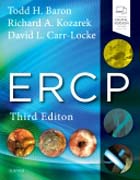
Over the past 40 years, ERCP has become an effective therapeutic modality with diagnostic purposes that are continually improved.. The 3rd Edition of this practical reference helps you make the most of today's endoscopic retrograde cholangiopancreatography in your practice. You'll find authoritative, highly illustrated guidance on every aspect of ERCP, including coverage of the latest techniques both in print and on video. INDICE: Section I GENERAL TOPICS 1. Four Decades: The History and Future of ERCP 2. The ERCP Room 3. Radiologic Issues and Radiation Safety During ERCP 4. Endoscopes, Guidewires and Accessories 5. Duodenoscope Reprocessing 6. Sedation in ERCP 7. Indications for and Contraindications to ERCP including when and when not to perform ERCP 8. Adverse Events of ERCP: Prediction, Prevention and Management 9. ERCP Training 10. Preparation for ERCP 11. Principles of Electrosurgery 12. Quality Issues and Measures in ERCP 13. Medicolegal Issues in ERCP Section II TECHNIQUES 14. Cannulation of the Major Papilla 15. Access (Precut) Papillotomy 16. Sphincter of Oddi Manometry 17. Biliary Sphincterotomy 18. Balloon Dilation of the Native and Postsphincterotomy Papilla 19. Stone Extraction 20. Pancreatic Sphincterotomy 21. Minor Papilla Cannulation and Papillotomy 22. Plastic Pancreaticobiliary Stents and Nasopancreaticobiliary Tubes: Concepts and Insertion Techniques 23. Biliary Metal Stent Insertion: Indications and insertion techniques 24. Pancreaticobiliary Stent Removal: Migrated and Non-Migrated 25. Papillectomy and Ampullectomy 26. Pancreatoscopy 27. Cholangioscopy 28. Endomicroscopy Ninepoint of the Pancreaticobiliary Tree 29. ERCP in Children 30. ERCP in Pregnancy 31. ERCP in Surgically Altered Anatomy 32. Endoscopic Ultrasound-Guided Biliary Drainage 33. Endoscopic Ultrasound and EUS Guided Endotherapy Section III APPROACH TO CLINICAL PROBLEMS 34. Pancreaticobiliary Disorders. What is the role of CT, MRCP, and EUS relative to ERCP? 35. Pancreas Divisum, Biliary Cysts, and Other Congenital Anomalies 36. Approach to the Dilated Bile Duct and Pneumobilia 37. The Dilated Pancreatic Duct 38. Ampullary Neoplasia 39. Malignant Biliary Obstruction: Distal 40. Malignant Biliary Obstruction of the Hilum and Proximal Bile Ducts including Radiofrequency Ablation for Cancer and percutaneous vs. endoscopic drainage 41. Indeterminate Biliary Stricture 42. Combined Biliary and Duodenal Obstruction w/EUS including percutaneous versus endoscopic drainage 43. Benign Biliary Strictures 44. Biliary Surgery Adverse Events including Liver Transplantation 45. ERCP for Acute and Chronic Adverse Events of Pancreatic Surgery and Pancreatic Trauma 46. Choledocholithiasis 47. Pancreatobiliary Pain and Suspected Sphincter of Oddi Dysfunction 48. Sclerosing Cholangitis 49. Tropical Parasitic Infections 50. Recurrent Pyogenic Cholangitis 51. Cystic Lesions of the Pancreas 52. Unexplained Acute Pancreatitis and ARP 53. Biliary Intervention in Acute Gallstone Pancreatitis 54. Pancreatic Interventions in Acute Pancreatitis: Ascites, Fistulae, Leaks, and Other Disruptions 55. Chronic Pancreatitis: Stones and Strictures 56. Endoscopic Drainage of Pancreatic Pseudocysts, Abscesses and Walled-Off (Organized) Necrosis with Update on Pancreatic Necrosis
- ISBN: 978-0-323-48109-0
- Editorial: Elsevier
- Encuadernacion: Cartoné
- Páginas: 550
- Fecha Publicación: 01/03/2018
- Nº Volúmenes: 1
- Idioma: Inglés
